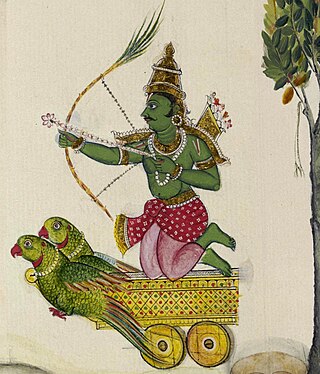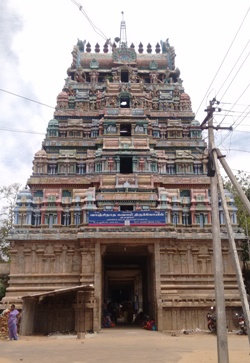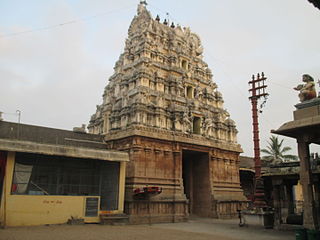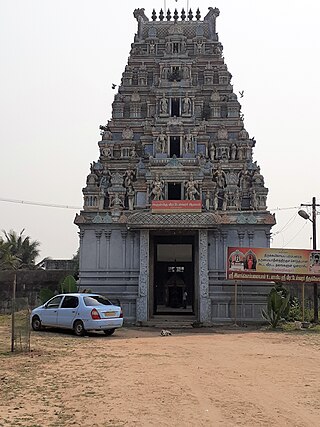
Rati is the Hindu goddess of love, carnal desire, lust, passion, and sexual pleasure. Usually described as the daughter of Prajapati Daksha, Rati is the female counterpart, the chief consort and the assistant of Kama (Kamadeva), the god of love. A constant companion of Kama, she is often depicted with him in legend and temple sculpture. She also enjoys worship along with Kama.

The Kapaleeshwarar Temple is a Hindu temple dedicated to the god Shiva located in Mylapore, Chennai in the Indian state of Tamil Nadu. The temple was built around the 7th century CE and is an example of South Indian Architecture.

Kama, also known as Kamadeva and Manmatha, is the Hindu god of erotic love, desire, pleasure and beauty, often portrayed alongside his consort and female counterpart, Rati. He is depicted as a handsome young man decked with ornaments and flowers, armed with a bow of sugarcane and shooting arrows of flowers.

Thiruvathigai Veerateswarar Temple is a Hindu temple dedicated to Shiva. It is situated in Thiruvathigai village which is about 2 kilometres east from the town of Panruti in the South Indian state of Tamil Nadu, India. Shiva is worshiped as Veerattaaneswarar, and is represented by the lingam. His consort Parvati is depicted as Thiripurasundari. The presiding deity is revered in the 7th-century Tamil Saiva canonical work, the Tevaram, written by Tamil saint poets known as the nayanars and classified as Paadal Petra Sthalam. The temple is considered the place where the Saiva saint poet Appar (Thirunavukkarasar) converted back to Saivism, and attained final salvation.

Kandeeswarar Temple is a Hindu temple dedicated to the god Shiva located in Kandiyur also known as Thirukkandiyur or Tirukkandiyur, near Tiruvaiyaru, Tamil Nadu, India. Shiva is worshiped as Kandeeswarar, and is represented by the lingam and his consort Parvati is depicted as Mangalanayagi. The presiding deity is revered in the 7th century Tamil Saiva canonical work, the Tevaram, written by Tamil poet saints known as the nayanars and classified as Paadal Petra Sthalam. As per legends, Shiva is believed to have destroyed eight different demons and the eight Ashta Veeratanam temples are built signifying each of his victories in the war. The temple is one of the eight where Shiva is believed to have removed one of the five heads of Brahma.

Maanturai Amravaneswarar Temple, is a temple dedicated to Hindu deity Shiva, located in Manturai, a village in the outskirts of Trichy, in the South Indian state of Tamil Nadu. It is one of the 275 Paadal Petra Sthalams, where the three of the most revered Nayanars, Appar and Tirugnana Sambandar have glorified the temple with their verses during the 7th-8th century. The temple has been widely expanded by Chola kings during the 11th century. The temple has three tiered gateway tower and a tank. Since Shiva bestowed a deer with a mango, this place is called Manthurai.

Vanchinadha Swamy temple is a Hindu temple dedicated to the deity Shiva, located in Srivanchiyam, Tiruvarur District, Tamil Nadu, India. Shiva is worshiped as Vanchinadha Swamy, and is represented by the lingam. His consort Parvati is depicted as Mangalambigai Amman. The presiding deity is revered in the 7th century Tamil Saiva canonical work, the Tevaram, written by Tamil saint poets known as the Nayanmars and classified as Paadal Petra Sthalam.

Irattai Tirupati Temples refer to two temples of the Nava Tirupati, namely, the Devapiran temple and Aravindalochanar temple, which are dedicated to Vishnu. They are part of the nine "Divya Desams" located along the Tiruchendur-Tirunelveli route in Tamil Nadu, India on the banks of Thamiraparani river. The two temples are located adjacent to each other. All nine temples are part of the 108 temples of Vishnu revered by the 12 poet saint Alvars. The Irattai Tirupati is a Ketu Sthalam, sacred to the deity Ketu. Constructed in the Dravidian style of architecture, the temples are dedicated to Vishnu who is worshipped as Devapiran and Aravindalochanar and Lakshmi as Varagunavalli and Karuthadankanni.

Vedapuriswarar Temple, Thiruvedhikudi or Vazhaimadunathar Temple is a Hindu temple dedicated to Shiva located in Thiruvedhikudi near Tiruvaiyaru, Tamil Nadu, India. The presiding deity is revered in the 7th century Tamil Saiva canonical work, the Tevaram, written by Tamil poet saints known as the nayanars and classified as Paadal Petra Sthalam. The temple is counted as the earliest of all Chola temples.

Mela Kadambur Amirthakadeswarar Temple is a Hindu temple located at Melakadambur in Cuddalore district of Tamil Nadu, India. The historical name of the place is Tirukadambur. The presiding deity is Shiva. He is called as Amirtha Kadeswarar. His consort is known as Vidyujothi Nayaki. The temple has beautiful sculptures and the vimana is in the form of a chariot. It was built by emperor Kulottunga Chola I.

Kodeeswarar Temple(Tamil: :கொட்டையூர் கோடீஸ்வரர் கோயில்) is a Hindu temple dedicated to Lord Shiva, located in Kottaiyur, a village on the western outskirts of Kumbakonam, in Thanjavur district, Tamil Nadu, India. Shiva is worshipped as Koteeswarar and His consort Parvathi as Pandhadu Nayaki. Lord Koteeswarar is revered in the 7th century Tamil Saiva canonical and greatest work, Tevaram, written by Tamil saint poets known as the Nayanmars and classified as Paadal Petra Sthalam, the 275 temples revered in the canon.

Sathyanatheswarar Temple is a Hindu temple dedicated to Shiva, located in the town of Thirukalimedu, near Indira Theertham Kanchipuram, Kanchipuram district in Tamil Nadu, India. Shiva is worshipped as Sathyanatheswarar and his consort Parvathi as Pramarambikai. Sathyanatheswarar is revered in the 7th-century CE Tamil Saiva canonical work, the Tevaram, written by Tamil saint poets known as the nayanars and classified as Paadal Petra Sthalam, the 275 temples revered in the canon.

Kachabeswarar Temple, Thirukachur is a Hindu temple dedicated to the deity Shiva, located in Thirukachur, a village in Kanchipuram district in the South Indian state of Tamil Nadu. Shiva is worshipped as Kachabeswarar, and is represented by the lingam. His consort Parvati is depicted as Antanatchi and Kanniyumaiyal. The presiding deity is revered in the 7th-century CE Tamil Saiva canonical work, the Tevaram, written by Tamil saint poets known as the Nayanars and classified as Paadal Petra Sthalam. The temple is counted as a twin temple along with Marundeeswarar Temple located in the same village.

Veerateeswarar Temple in Tirukoilur, a panchayat town in Kallakurichi district in the South Indian state of Tamil Nadu, is dedicated to the Hindu god Shiva. Constructed in the Dravidian style of architecture, the temple is believed to have been built during the Cholas period in the 10th century. Shiva is worshipped as Veerateeswarar and his consort Parvathi as Periyanayagi.

Marundeeswarar Temple is a Hindu temple dedicated to the deity Shiva, located in T. Edaiyar, a village in Viluppuram district in the South Indian state of Tamil Nadu. Shiva is worshipped as Marundeeswarar, and is represented by the lingam. His consort Parvati is depicted as Balambigai. The temple is located on the Southern banks of Thenpennai River on the Thirukoilur - Thiruvennainallur road. The presiding deity is revered in the 7th century Tamil Saiva canonical work, the Tevaram, written by Tamil saint poets known as the nayanmars and classified as Paadal Petra Sthalam.

Narthana Vallabeswarar Temple is a Hindu temple dedicated to the deity Shiva, located in Thirukoodalaiyathoor, a village in Cuddalore district in the South Indian state of Tamil Nadu. Shiva is worshipped as Narthana Vallabeswarar, and is represented by the lingam. His consort Parvati is depicted as Gnanasakthi and Parasakthi. The presiding deity is revered in the 7th century Tamil Saiva canonical work, the Tevaram, written by Tamil saint poets known as the Nayanars and classified as Paadal Petra Sthalam.

Veerateswarar Temple is a Hindu temple located at Keelaparasalur in Mayiladuthurai district of Tamil Nadu, India. The historical name of the place is Tirupparialur. The presiding deity is Shiva in the form of Veerateswarar and his consort is known as Ilam Kobanayal. The presiding deity is revered in the 7th century Tamil Saiva canonical work, the Tevaram, written by Tamil saint poets known as the nayanars and classified as Paadal Petra Sthalam, the 276 temples that find mention in it.

Veerateeswarar Temple is a Hindu temple located at Vazhuvur in Mayiladuthurai district of Tamil Nadu, India. The presiding deity is Shiva in the form of Veerateswarar and his consort is known as Bala Gujambigai. The village is mentioned in the 7th century Tamil Saiva canonical work, the Tevaram, written by Tamil saint poets known as the nayanars and classified as Vaippu Sthalam, the 276 temples that find mention in it.

Veerateeswarar Temple is a Hindu temple located at Thiruvirkudi in Mayiladuthurai district of Tamil Nadu, India. The presiding deity is Shiva in the form of Veerateswarar and his consort is known as Elavar Kuzhali. The presiding deity is revered in the 7th century Tamil Saiva canonical work, the Tevaram, written by Tamil saint poets known as the nayanars and classified as Paadal Petra Sthalam, the 276 temples that find mention in it.

Thirumeninathar temple is a Hindu temple dedicated to the deity Shiva, located in Tiruchuli in Virudhunagar district, in the South Indian state of Tamil Nadu. Shiva is worshipped as Thirumeninathar, and is represented by the lingam. His consort Parvati is depicted as Thunaimalaiyammai Amman. The temple is located on the Virudhunagar–Manamadurai road. The presiding deity is revered in the 7th-century-CE Tamil Saiva canonical work, the Tevaram, written by Tamil saint poets known as the nayanmars and classified as Paadal Petra Sthalam. The temple is closely associated with Sundarar, who has sung praises about the presiding deity. This shrine is regarded as the 12th of the Tevara Stalams in the Pandya region of Tamil Nadu.
























